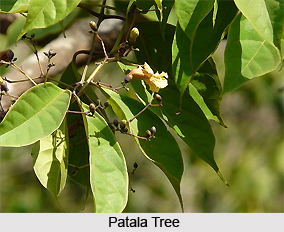 The medium-sized deciduous tree, Patala is a useful Indian medicinal plant that is botanically known as Stereospermum chelonoides. The plant has several names in various native Indian languages. In Bengali it is called Ghunta, Mug, Parul and Paruli. Apart from Padal, the plant is called is also called Padaria, Padiala or Paral in Hindi, as well. Patala is the Sanskrit name of the plant and it is called as Kalagari, Padal, Padialu, Parul, and Patala in Marathi. While in Tamil Nadu it is Anbu-Vagini, Padiri or Padri, in Telegu it is popular as Ambuvasini, Goddalipulusu, Kalagoru, Kaligotu, Kokkesa, Kuberakshi, Patali and Peddakalaguri.
The medium-sized deciduous tree, Patala is a useful Indian medicinal plant that is botanically known as Stereospermum chelonoides. The plant has several names in various native Indian languages. In Bengali it is called Ghunta, Mug, Parul and Paruli. Apart from Padal, the plant is called is also called Padaria, Padiala or Paral in Hindi, as well. Patala is the Sanskrit name of the plant and it is called as Kalagari, Padal, Padialu, Parul, and Patala in Marathi. While in Tamil Nadu it is Anbu-Vagini, Padiri or Padri, in Telegu it is popular as Ambuvasini, Goddalipulusu, Kalagoru, Kaligotu, Kokkesa, Kuberakshi, Patali and Peddakalaguri.
Patala has a medium height of 9-18 m and its bark is grey or dark brown. The horizontally furrowed tree exfoliates in large, flat scales. The leaves are simple pinnate, having a length of 30-60 cm and they have 3-4 pairs of leaflets also. The terminal one has a length of 7.5-15 cm and width of 5-7.5 cm and it is broadly elliptic. The apex of Patala is shortly abruptly acuminate and the margins often serrulate when young. The apex is rough above, often pubescent beneath with usually rounded and unequal-sided base. There are 6-8 pairs of main nerves and the petiolules of lateral leaflets are generally less than 2.5 mm long. The flowers of Patala have sweet fragrance and they are borne in large, lax trichotomous that are viscidly hairy panicles.
The calyx of Patala is 1 cm long and shaped like a bell or campana. It is viscidly hairy, has 3-5 lobes that are short and broad. The corolla of this Indian medicinal plant is tubular, campanulate with dull crimson or purple colour. The corolla is yellow within; its limb is oblique and 2-lipped. The lobes are rounded, crisped-crenate and the lower 3 lobes are usually longer than the 2 upper. The fruit or capsule of the plant is cylindrical, slightly ribbed and usually straight. The Patala fruit is somewhat rough with elevated whitish specks and the valves are thick and hard.
Patala usually flowers at the beginning of the dry season, after the leaves have been shed. The plant is a native to India and commonly found throughout most of India in mixed deciduous and sal-dominated forests. The plant is most common in the sub-Himalayan tract to an altitude of 1500 m. The plant occurs, often gregariously, on clayey soils, in valleys and on plateaux in Rajasthan, Bihar (Chota Nagpur), Madhya Pradesh and many parts of peninsular India.
Patala has numerous medicinal properties and usages. The plant`s root is considered bitter, astringent, cardiotonic, cooling, diuretic and tonic, in Ayurveda. The root is mainly used in the treatment of inflammations, vomiting, asthma, fevers, anasarca and the diseases of the blood and distaste. A decoction of the roots is also used for treating intermittent and puerperal fevers, inflammatory chest affections, and affections of the brain. A combination of the root bark and other plant drugs is generally used as an ingredient of the compound Ayurvedic formulations like Dasamularistam, Dhanvantaram tailam, Cvavanaprasam and Agastyarasayanam. The ethanolic extracts of the roots of this plant have reportedly shown anti-cancer activity against human epidermal carcinoma of the nasopharynx in tissue-culture studies.
The Gonds of Uttar Pradesh use a decoction of the root of Patala or Padal, along with the root of Curcuma longa (Zingiberaceae) and jaggery in the treatment of fever accompanying childbirth. They also give the root extract, along with that of Sida rhombifolia (Malvaceae), orally to clear the uterus after childbirth. The stem bark of the plant is considered to have diuretic and tonic properties. Apart from that, the flowers of the plant are also considered useful for treating bilious diarrhoea and burning sensations in Ayurveda. The practitioners of Ayurvedic medicine use the fruits for treating leprosy and strangury, as well. They give the fruits along with honey for controlling hiccups. The people in Tamil Nadu also sometimes eat the fruits in the form of a confection as an aphrodisiac.











